Detection of Sulfite Dioxide Residue on the Surface of Fresh-Cut Potato Slices Using Near-Infrared Hyperspectral Imaging System and Portable Near-Infrared Spectrometer
Abstract
1. Introduction
2. Results
2.1. Spectral Profile
2.2. Principal Component Analysis
2.3. SVM Models Based on Full Spectra
2.4. Important Wavelength Recognize
2.5. SVM Models Based on Important Wavelengths
3. Discussion
4. Materials and Methods
4.1. Materials and Sample Preparation
4.2. Portable Near-Infrared Spectrometer
4.3. Near-Infrared Hyperspectral Imaging System and Spectra Extraction
4.3.1. Near-Infrared Hyperspectral Imaging System
4.3.2. Spectra Extraction
4.4. Data analysis
4.4.1. Principal Component Analysis
4.4.2. Important Wavelength Recognition Method
4.4.3. Classification Analysis Method
4.4.4. Software
5. Conclusions
Author Contributions
Funding
Acknowledgments
Conflicts of Interest
References
- Ji, Y.; Sun, L.; Li, Y.; Li, J.; Liu, S.; Xie, X.; Xu, Y. Non-destructive classification of defective potatoes based on hyperspectral imaging and support vector machine. Infrared Phys. Techn. 2019, 99, 71–79. [Google Scholar] [CrossRef]
- Liu, X.; Yang, Q.; Lu, Y.; Li, Y.; Li, T.; Zhou, B.; Qiao, L. Effect of purslane (Portulaca oleracea L.) extract on anti-browning of fresh-cut potato slices during storage. Food Chem. 2019, 283, 445–453. [Google Scholar] [CrossRef] [PubMed]
- Liu, X.; Wang, T.; Lu, Y.; Yang, Q.; Li, Y.; Deng, X.; Liu, Y.; Du, X.; Qiao, L.; Zheng, J. Effect of high oxygen pretreatment of whole tuber on anti-browning of fresh-cut potato slices during storage. Food Chem. 2019, 301, 125287. [Google Scholar] [CrossRef] [PubMed]
- Ma, L.; Zhang, M.; Bhandari, B.; Gao, Z. Recent developments in novel shelf life extension technologies of fresh-cut fruits and vegetables. Trends Food Sci. Techn. 2017, 64, 23–38. [Google Scholar] [CrossRef]
- Li, L.; Bai, J.; Wu, M.; Zhao, M.; Wang, R.; Guo, M.; Liu, H.; Liu, T. Studies on browning inhibition technology and mechanisms of fresh-cut potato. J. Food Process. Preserv. 2017, 41. [Google Scholar] [CrossRef]
- Lante, A.; Tinello, F.; Nicoletto, M. UV-A light treatment for controlling enzymatic browning of fresh-cut fruits. Innov. Food Sci. Emerg. 2016, 34, 141–147. [Google Scholar] [CrossRef]
- Gong, Y.; Wang, Q.; Ma, S.; Ma, Y.; Meng, Q.; Zhang, Z.; Shi, J. Short-time water immersion inhibits browning of fresh-cut potato by enhancing antioxidant capability and tyrosine scavenging. J. Food Process. Preserv. 2019, 43. [Google Scholar] [CrossRef]
- Singh, B.; Suri, K.; Shevkani, K.; Kaur, A.; Kaur, A.; Singh, N. Enzymatic Browning of Fruit and Vegetables: A Review. In Enzymes in Food Technology; Kuddus, M., Ed.; Springer Nature Singapore Pte Ltd.: Singapore, 2018; pp. 63–78. [Google Scholar]
- Bobo-García, G.; Arroqui, C.; Merino, G.; Vírseda, P. Antibrowning Compounds for Minimally Processed Potatoes: A Review. Food Rev. Int. 2019, 1–18. [Google Scholar] [CrossRef]
- Yu, G.; Zhang, Z.; Yang, G.; Wang, W.; Cai, Z.; Zheng, W.; Xu, L. The immersion test and risk assessment for water bamboo on sodium pyrosulfite. Acta Agric. Zhejiangensis 2015, 27, 2011–2016. [Google Scholar]
- Do Nascimento, R.F.; Canteri, M.H.G. Use of sodium metabisulfite and ascorbic acid as anti-browning agents in processed potatoes. Brit. Food J. 2019, 122, 380–389. [Google Scholar] [CrossRef]
- Tian, J.; Yi, H. Effect of sodium metabisulfite soaking treatment on Muscat Hamburg table grapes storage. Food Sci. Technol. Int. 2018, 43, 44–49. [Google Scholar] [CrossRef]
- Wang, Z. Use and Determination of Sulfites in Foods. Mod. Food 2016, 24, 75–78. [Google Scholar] [CrossRef]
- Luo, X.; Guo, X.; Zhang, X.; Wang, Z.; Dou, H.; Yao, W. Research progress on the determination methods of sulfite in food. J. Food Saf. Qual. 2019, 10, 2611–2616. [Google Scholar]
- Zhang, J.; Ma, Z.; Wang, Y.; Li, N.; Chen, S.; Li, J. Review of toxicity and determination method of sulfite in food products. J. Food Saf. Qual. 2015, 6, 3211–3216. [Google Scholar]
- Zheng, Q. Sulfite Addition and Detection in Food Processing. Mod. Food 2017, 5. [Google Scholar] [CrossRef]
- Zhang, C.; Jiang, H.; Liu, F.; He, Y. Application of Near-Infrared Hyperspectral Imaging with Variable Selection Methods to Determine and Visualize Caffeine Content of Coffee Beans. Food Bioprocess. Techn. 2016, 10, 213–221. [Google Scholar] [CrossRef]
- Zhuang, J.J.; Luo, S.M.; Hou, C.J.; Tang, Y.; He, Y.; Xue, X.Y. Detection of orchard citrus fruits using a monocular machine vision-based method for automatic fruit picking applications. Comput. Electron. Agr. 2018, 152, 64–73. [Google Scholar] [CrossRef]
- Nogales-Bueno, J.; Feliz, L.; Baca-Bocanegra, B.; Hernandez-Hierro, J.M.; Heredia, F.J.; Barroso, J.M.; Rato, A.E. Comparative study on the use of three different near infrared spectroscopy recording methodologies for varietal discrimination of walnuts. Talanta 2020, 206, 120189. [Google Scholar] [CrossRef]
- Wang, T.; Chen, J.; Fan, Y.; Qiu, Z.; He, Y. SeeFruits: Design and evaluation of a cloud-based ultra-portable NIRS system for sweet cherry quality detection. Comput. Electron. Agr. 2018, 152, 302–313. [Google Scholar] [CrossRef]
- Santos, P.M.; Pereira-Filho, E.R.; Rodriguez-Saona, L.E. Application of hand-held and portable infrared spectrometers in bovine milk analysis. J. Agric. Food Chem. 2013, 61, 1205–1211. [Google Scholar] [CrossRef]
- Su, W.; Sun, D. Potential of hyperspectral imaging for visual authentication of sliced organic potatoes from potato and sweet potato tubers and rapid grading of the tubers according to moisture proportion. Comput. Electron. Agr. 2016, 125, 113–124. [Google Scholar] [CrossRef]
- Šašic, S.; Ozaki, Y. Short-wave near-infrared spectroscopy of biological fluids. 1. Quantitative analysis offat, protein, and lactose in rawmilk by partial least-squares regression and band assignment. Anal. Chem. 2001, 73, 64–71. [Google Scholar]
- Khodabux, K.; L’Omelette, M.S.S.; Jhaumeer-Laulloo, S.; Ramasami, P.; Rondeau, P. Chemical and near-infrared determination of moisture, fat and protein in tuna fishes. Food Chem. 2007, 102, 669–675. [Google Scholar] [CrossRef]
- Yang, S.; Zhu, Q.B.; Huang, M.; Qin, J. Hyperspectral Image-Based Variety Discrimination of Maize Seeds by Using a Multi-Model Strategy Coupled with Unsupervised Joint Skewness-Based Wavelength Selection Algorithm. Food Anal. Methods 2016, 10, 424–433. [Google Scholar] [CrossRef]
- Kamruzzaman, M.; Barbin, D.; ElMasry, G.; Sun, D.; Allen, P. Potential of hyperspectral imaging and pattern recognition for categorization and authentication of red meat. Innov Food Sci Emerg Technol. 2012, 6, 316–325. [Google Scholar] [CrossRef]
- Zhang, C.; Feng, X.; Wang, J.; Liu, F.; He, Y.; Zhou, W. Mid-infrared spectroscopy combined with chemometrics to detect Sclerotinia stem rot on oilseed rape (Brassica napus L.) leaves. Plant. Methods 2017, 13, 39. [Google Scholar] [CrossRef]
- Liu, D.; Sun, D.; Zeng, X. Recent Advances in Wavelength Selection Techniques for Hyperspectral Image Processing in the Food Industry. Food Bioprocess. Techn. 2014, 7, 307–323. [Google Scholar] [CrossRef]
- Kimuli, D.; Wang, W.; Lawrence, K.C.; Yoon, S.C.; Ni, X.; Heitschmidt, G.W. Utilisation of visible/near-infrared hyperspectral images to classify aflatoxin B 1 contaminated maize kernels. Biosyst. Eng. 2018, 166, 150–160. [Google Scholar] [CrossRef]
- Zheng, X.; Li, Y.; Wei, W.; Peng, Y. Detection of adulteration with duck meat in minced lamb meat by using visible near-infrared hyperspectral imaging. Meat Sci. 2019, 149, 55–62. [Google Scholar] [CrossRef]
- Ma, H.L.; Wang, J.W.; Chen, Y.J.; Cheng, J.L.; Lai, Z.T. Rapid authentication of starch adulterations in ultrafine granular powder of Shanyao by near-infrared spectroscopy coupled with chemometric methods. Food Chem. 2017, 215, 108–115. [Google Scholar] [CrossRef]
- Manley, M. Near-infrared spectroscopy and hyperspectral imaging: Non-destructive analysis of biological materials. Chem. Soc. Rev. 2014, 43, 8200–8214. [Google Scholar] [CrossRef] [PubMed]
- Yuan, K.; Wang, X.; Zhang, L.; Gu, D.; Guo, X.; Fan, Z. Rapid and quantitative determination of sulfite residue in tremella based on IR spectroscopy and PLS. Food Mach. 2017, 33, 64–67, 134. [Google Scholar] [CrossRef]
- Chao, K.; Chin, B.A.; Cho, B.; Kim, M.S.; De Biasio, M.; Arnold, T. Study of near-infrared imaging spectroscopy for the inspection of peeled potato tubers. In Sensing for Agriculture and Food Quality and Safety X; SPIE: Orlando, FL, USA, 2018. [Google Scholar]
- Escuredo, O.; Seijo-Rodríguez, A.; González-Martín, M.I.; Rodríguez-Flores, M.S.; Seijo, M.C. Potential of near infrared spectroscopy for predicting the physicochemical properties on potato flesh. Microchem. J. 2018, 141, 451–457. [Google Scholar] [CrossRef]
- Liang, P.; Haff, R.P.; Hua, S.T.; Munyaneza, J.E.; Mustafa, T.; Sarreal, S.B.L. Nondestructive detection of zebra chip disease in potatoes using near-infrared spectroscopy. Biosyst. Eng. 2018, 166, 161–169. [Google Scholar] [CrossRef]
- Feng, L.; Zhu, S.; Zhang, C.; Bao, Y.; Feng, X.; He, Y. Identification of Maize Kernel Vigor under Different Accelerated Aging Times Using Hyperspectral Imaging. Molecules 2018, 23, 3078. [Google Scholar] [CrossRef] [PubMed]
- Zhang, C.; Wang, Q.; Liu, F.; He, Y.; Xiao, Y. Rapid and non-destructive measurement of spinach pigments content during storage using hyperspectral imaging with chemometrics. Measurement 2017, 97, 149–155. [Google Scholar] [CrossRef]
- Kong, W.; Zhang, C.; Huang, W.; Liu, F.; He, Y. Application of Hyperspectral Imaging to Detect Sclerotinia sclerotiorum on Oilseed Rape. Stems. Sens. (Basel) 2018, 18, 123. [Google Scholar] [CrossRef]
- Cirino de Carvalho, L.; De Lelis Medeiros de Morais, C.; Gomes de Lima, K.M.; Cunha Júnior, L.C.; Martins Nascimento, P.A.; Bosco de Faria, J.; Henrique de Almeida Teixeira, G. Determination of the geographical origin and ethanol content of Brazilian sugarcane spirit using near-infrared spectroscopy coupled with discriminant analysis. Anal. Methods 2016, 8, 5658–5666. [Google Scholar] [CrossRef]
- Wenz, J.J. Examine water in model membranes by near infrared spectroscopy and multivariate analysis. Biochim. Biophys. Acta Biomembr. 2018, 1860, 673–682. [Google Scholar] [CrossRef]
- Yin, W.; Zhang, C.; Zhu, H.; Zhao, Y.; He, Y. Application of near-infrared hyperspectral imaging to discriminate different geographical origins of Chinese wolfberries. PLoS ONE 2017, 12. [Google Scholar] [CrossRef]
- López-Maestresalas, A.; Insausti, K.; Jarén, C.; Pérez-Roncal, C.; Urrutia, O.; Beriain, M.J.; Arazuri, S. Detection of minced lamb and beef fraud using NIR spectroscopy. Food Control. 2019, 98, 465–473. [Google Scholar] [CrossRef]
- Ye, D.; Sun, L.; Tan, W.; Che, W.; Yang, M. Detecting and classifying minor bruised potato based on hyperspectral imaging. Chemom. Intell. Lab. Syst. 2018, 177, 129–139. [Google Scholar] [CrossRef]
- Zhang, C.; Shen, T.; Liu, F.; He, Y. Identification of Coffee Varieties Using Laser-Induced Breakdown Spectroscopy and Chemometrics. Sens. (Basel) 2017, 18, 95. [Google Scholar] [CrossRef] [PubMed]
Sample Availability: Sodium pyrosulfite standard is available from the authors. |
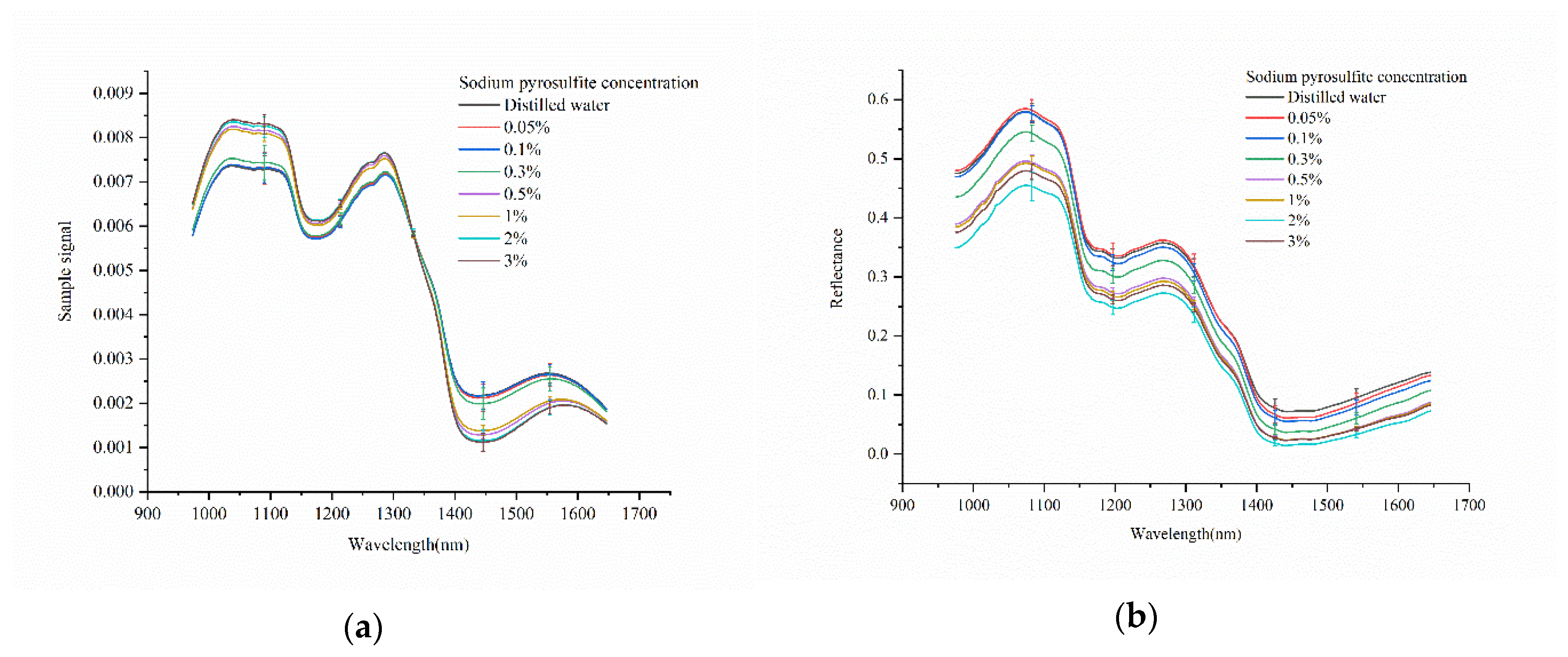
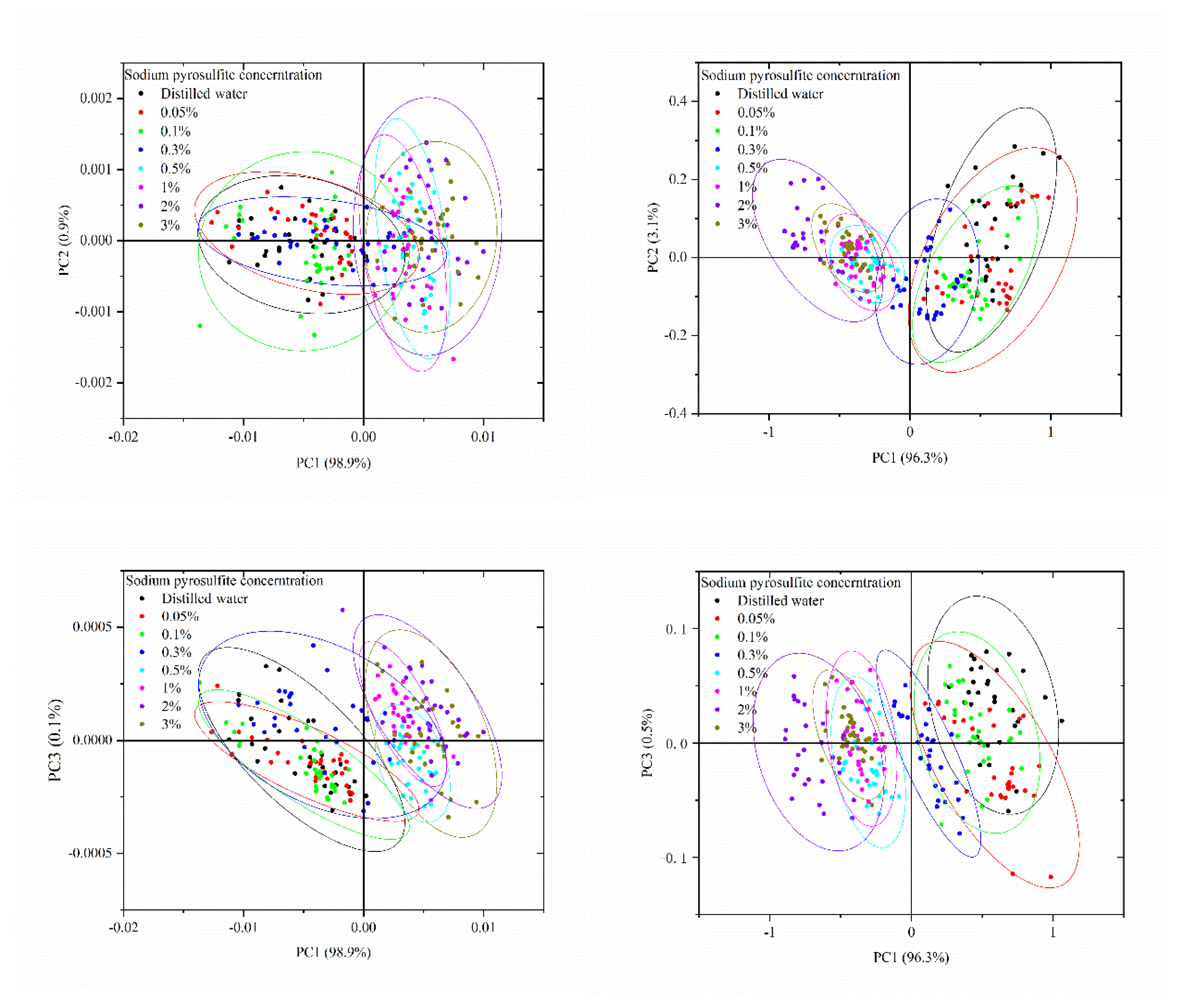
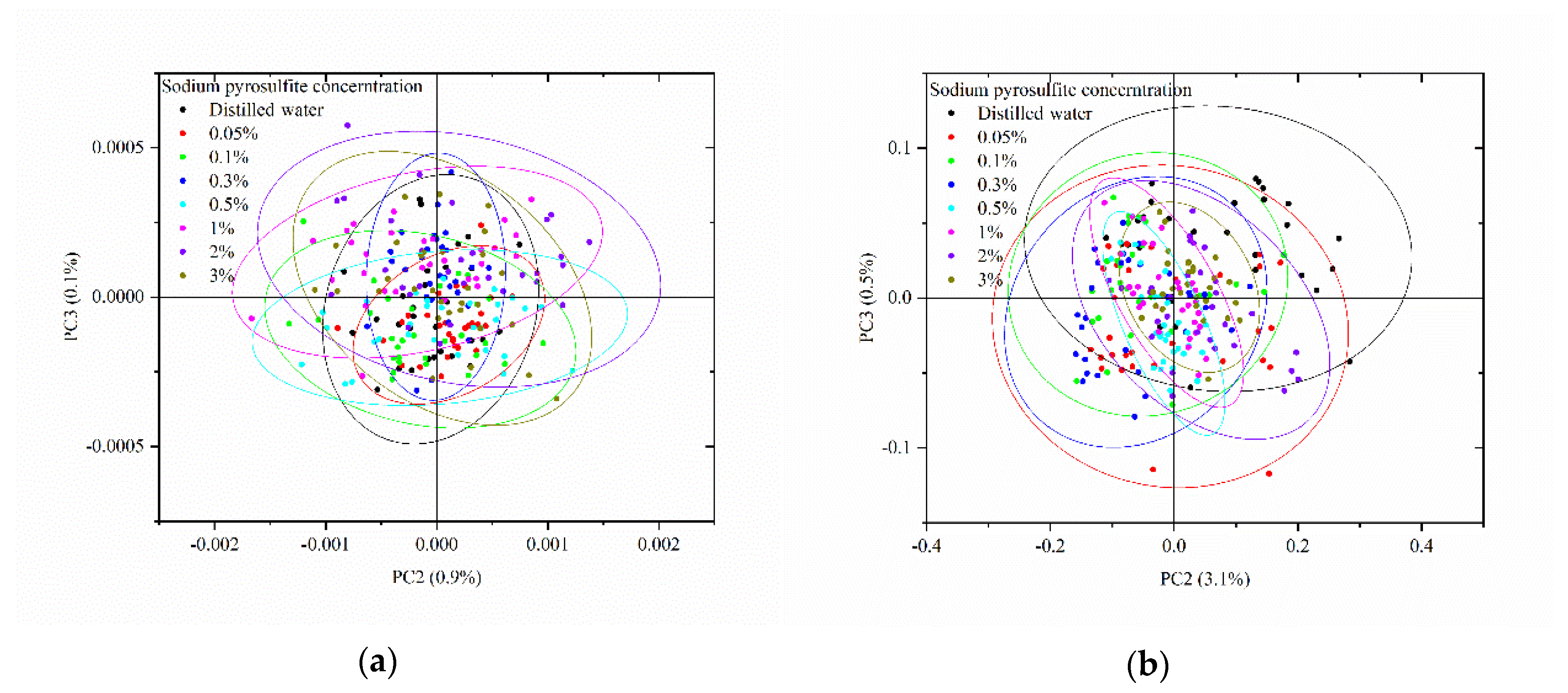
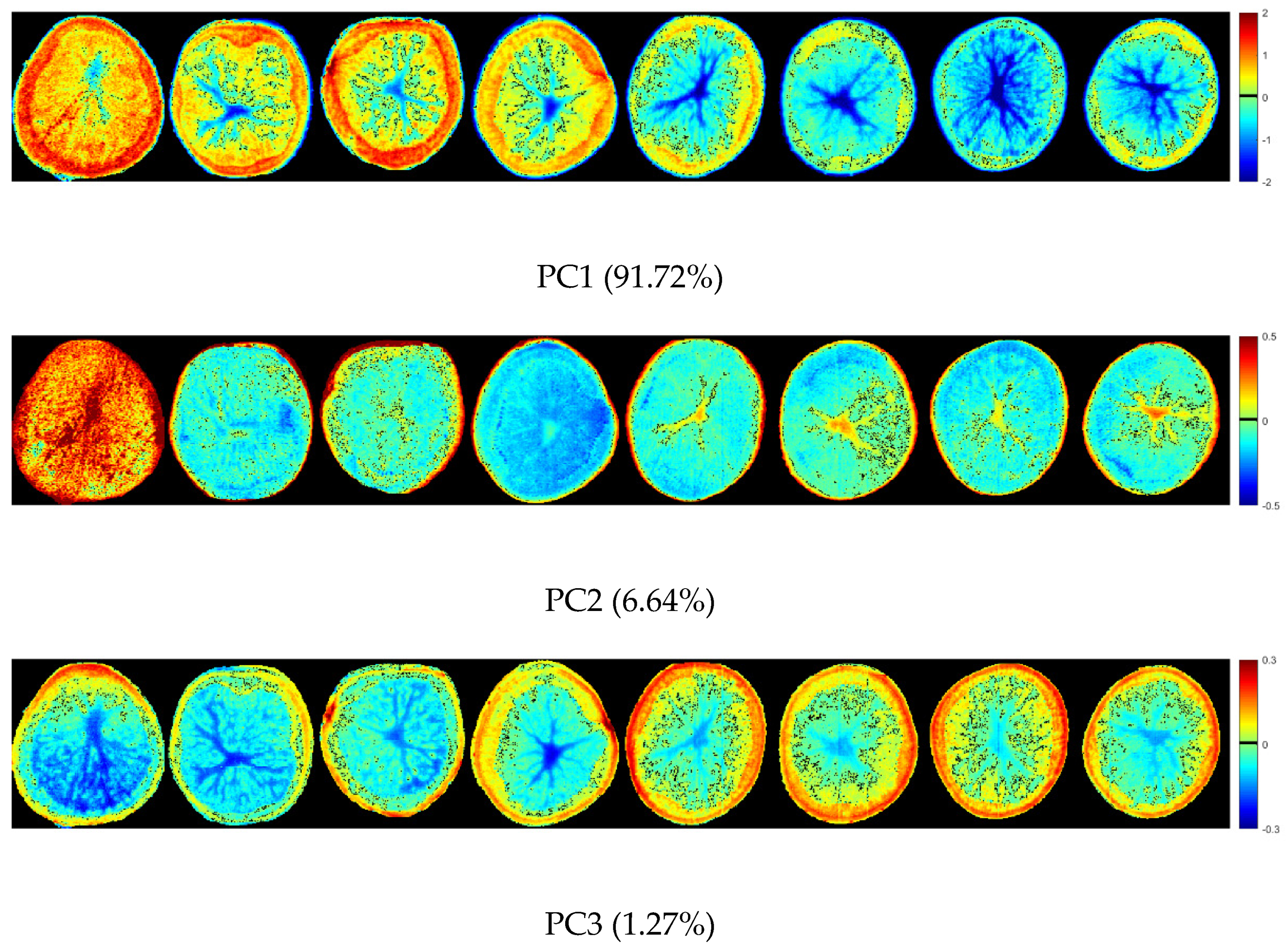
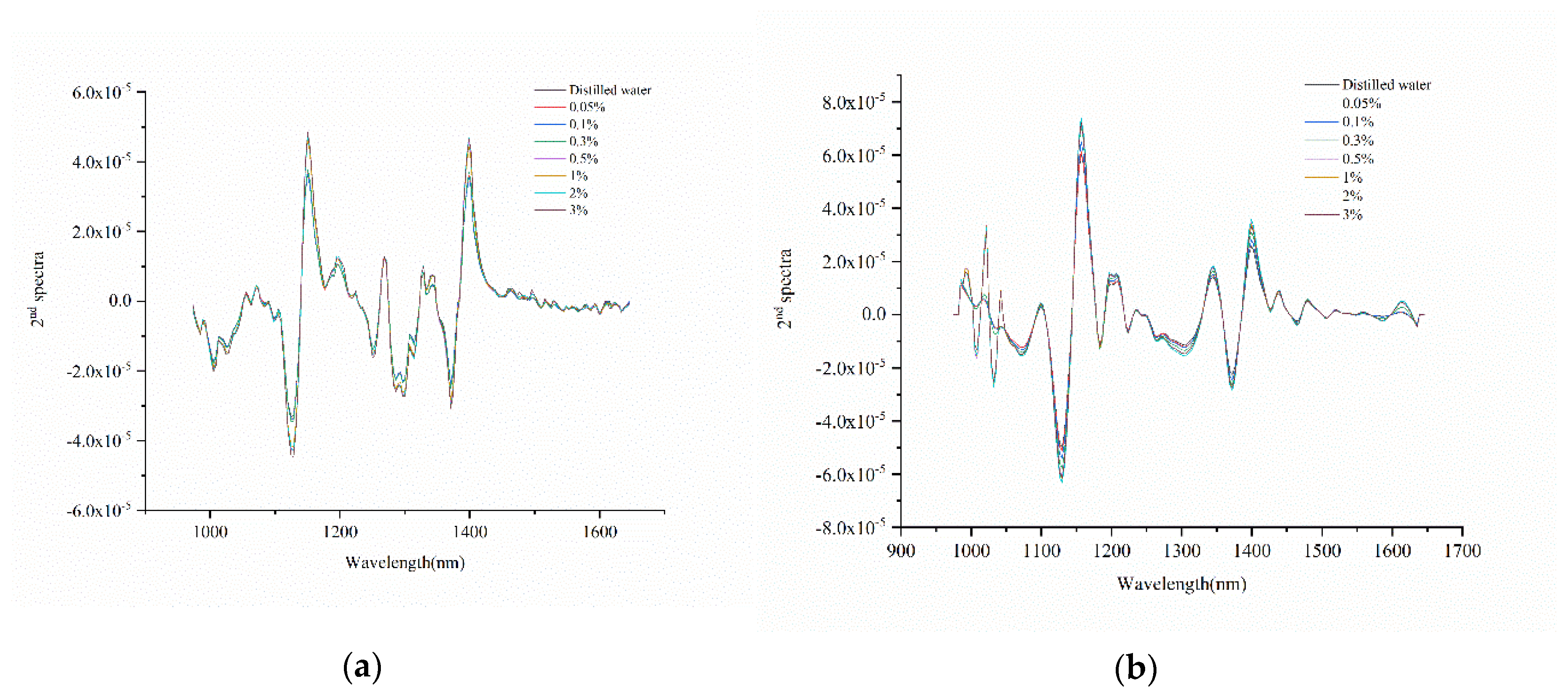
| 0% 1 | 0.05% | 0.10% | 0.30% | 0.50% | 1.00% | 2.00% | 3.00% | Accuracy | ||
|---|---|---|---|---|---|---|---|---|---|---|
| Cal.2 | 0% | 19 | 1 | 0 | 0 | 0 | 0 | 0 | 0 | 95.00% |
| 0.05% | 2 | 17 | 1 | 0 | 0 | 0 | 0 | 0 | 85.00% | |
| 0.10% | 0 | 0 | 19 | 1 | 0 | 0 | 0 | 0 | 95.00% | |
| 0.30% | 1 | 0 | 0 | 19 | 0 | 0 | 0 | 0 | 95.00% | |
| 0.50% | 0 | 0 | 0 | 0 | 20 | 0 | 0 | 0 | 100.00% | |
| 1.00% | 0 | 0 | 0 | 0 | 0 | 20 | 0 | 0 | 100.00% | |
| 2.00% | 0 | 0 | 0 | 0 | 0 | 0 | 20 | 0 | 100.00% | |
| 3.00% | 0 | 0 | 0 | 0 | 0 | 0 | 0 | 20 | 100.00% | |
| Total | 96.25% | |||||||||
| Pre.3 | 0% | 6 | 4 | 0 | 0 | 0 | 0 | 0 | 0 | 60.00% |
| 0.05% | 0 | 10 | 0 | 0 | 0 | 0 | 0 | 0 | 100.00% | |
| 0.10% | 1 | 1 | 8 | 0 | 0 | 0 | 0 | 0 | 80.00% | |
| 0.30% | 0 | 2 | 0 | 8 | 0 | 0 | 0 | 0 | 80.00% | |
| 0.50% | 0 | 0 | 0 | 1 | 9 | 0 | 0 | 0 | 90.00% | |
| 1.00% | 0 | 0 | 0 | 1 | 3 | 6 | 0 | 0 | 60.00% | |
| 2.00% | 0 | 1 | 0 | 0 | 0 | 0 | 5 | 4 | 50.00% | |
| 3.00% | 0 | 0 | 0 | 0 | 1 | 0 | 2 | 7 | 70.00% | |
| Total | 73.75% |
| 0% 1 | 0.05% | 0.10% | 0.30% | 0.50% | 1.00% | 2.00% | 3.00% | Accuracy | ||
|---|---|---|---|---|---|---|---|---|---|---|
| Cal.2 | 0% | 19 | 1 | 0 | 0 | 0 | 0 | 0 | 0 | 95.00% |
| 0.05% | 0 | 20 | 0 | 0 | 0 | 0 | 0 | 0 | 100.00% | |
| 0.10% | 0 | 0 | 20 | 0 | 0 | 0 | 0 | 0 | 100.00% | |
| 0.30% | 0 | 0 | 0 | 20 | 0 | 0 | 0 | 0 | 100.00% | |
| 0.50% | 0 | 0 | 0 | 0 | 19 | 1 | 0 | 0 | 95.00% | |
| 1.00% | 0 | 0 | 0 | 0 | 0 | 20 | 0 | 0 | 100.00% | |
| 2.00% | 0 | 0 | 0 | 0 | 0 | 0 | 20 | 0 | 100.00% | |
| 3.00% | 0 | 0 | 0 | 0 | 0 | 0 | 0 | 20 | 100.00% | |
| Total | 98.75% | |||||||||
| Pre.3 | 0% | 10 | 0 | 0 | 0 | 0 | 0 | 0 | 0 | 100.00% |
| 0.05% | 0 | 10 | 0 | 0 | 0 | 0 | 0 | 0 | 100.00% | |
| 0.10% | 0 | 1 | 9 | 0 | 0 | 0 | 0 | 0 | 90.00% | |
| 0.30% | 0 | 0 | 0 | 10 | 0 | 0 | 0 | 0 | 100.00% | |
| 0.50% | 0 | 0 | 0 | 0 | 8 | 2 | 0 | 0 | 80.00% | |
| 1.00% | 0 | 0 | 0 | 0 | 1 | 9 | 0 | 0 | 90.00% | |
| 2.00% | 0 | 0 | 0 | 0 | 0 | 0 | 10 | 0 | 100.00% | |
| 3.00% | 0 | 0 | 0 | 0 | 0 | 0 | 0 | 10 | 100.00% | |
| Total | 95.00% |
| Important Wavelengths(nm) | |
|---|---|
| Portable NIR Spectrometer | 913, 941, 962, 985, 1005, 1013, 1028, 1055, 1070, 1101, 1128, 1150, 1176, 1195, 1224, 1250, 1268, 1293, 1307, 1329, 1343, 1371, 1399, 1452, 1499, 1602 1633, 1646, 1667, 1692 |
| NIR-HSI System | 985, 992, 1009, 1022, 1032, 1042, 1072, 1099, 1130, 1156, 1183, 1200, 1207, 1224, 1237, 1247, 1264, 1274, 1304, 1345, 1372, 1399, 1426, 1440, 1467, 1480, 1507, 1521, 1558, 1588, 1612, 1636 |
| 0% 1 | 0.05% | 0.10% | 0.30% | 0.50% | 1.00% | 2.00% | 3.00% | Accuracy | ||
|---|---|---|---|---|---|---|---|---|---|---|
| Cal.2 | 0% | 19 | 1 | 0 | 0 | 0 | 0 | 0 | 0 | 95.00% |
| 0.05% | 2 | 14 | 4 | 0 | 0 | 0 | 0 | 0 | 70.00% | |
| 0.10% | 0 | 2 | 18 | 0 | 0 | 0 | 0 | 0 | 90.00% | |
| 0.30% | 1 | 0 | 0 | 19 | 0 | 0 | 0 | 0 | 95.00% | |
| 0.50% | 0 | 0 | 0 | 0 | 20 | 0 | 0 | 0 | 100.00% | |
| 1.00% | 0 | 0 | 0 | 0 | 0 | 20 | 0 | 0 | 100.00% | |
| 2.00% | 0 | 0 | 0 | 0 | 0 | 0 | 19 | 1 | 95.00% | |
| 3.00% | 0 | 0 | 0 | 0 | 0 | 0 | 0 | 20 | 100.00% | |
| Total | 93.13% | |||||||||
| Pre.3 | 0% | 6 | 3 | 0 | 1 | 0 | 0 | 0 | 0 | 60.00% |
| 0.05% | 0 | 9 | 1 | 0 | 0 | 0 | 0 | 0 | 90.00% | |
| 0.10% | 0 | 1 | 9 | 0 | 0 | 0 | 0 | 0 | 90.00% | |
| 0.30% | 0 | 2 | 0 | 8 | 0 | 0 | 0 | 0 | 80.00% | |
| 0.50% | 0 | 0 | 0 | 0 | 10 | 0 | 0 | 0 | 100.00% | |
| 1.00% | 0 | 0 | 0 | 1 | 2 | 7 | 0 | 0 | 70.00% | |
| 2.00% | 0 | 0 | 1 | 0 | 0 | 2 | 5 | 2 | 50.00% | |
| 3.00% | 0 | 0 | 0 | 0 | 3 | 0 | 1 | 6 | 60.00% | |
| Total | 75.00% |
| 0% 1 | 0.05% | 0.10% | 0.30% | 0.50% | 1.00% | 2.00% | 3.00% | Accuracy | ||
|---|---|---|---|---|---|---|---|---|---|---|
| Cal.2 | 0% | 19 | 1 | 0 | 0 | 0 | 0 | 0 | 0 | 95.00% |
| 0.05% | 0 | 20 | 0 | 0 | 0 | 0 | 0 | 0 | 100.00% | |
| 0.10% | 0 | 0 | 20 | 0 | 0 | 0 | 0 | 0 | 100.00% | |
| 0.30% | 0 | 0 | 0 | 20 | 0 | 0 | 0 | 0 | 100.00% | |
| 0.50% | 0 | 0 | 0 | 0 | 20 | 0 | 0 | 0 | 100.00% | |
| 1.00% | 0 | 0 | 0 | 0 | 0 | 20 | 0 | 0 | 100.00% | |
| 2.00% | 0 | 0 | 0 | 0 | 0 | 0 | 20 | 0 | 100.00% | |
| 3.00% | 0 | 0 | 0 | 0 | 0 | 0 | 0 | 20 | 100.00% | |
| Total | 99.38% | |||||||||
| Pre.3 | 0% | 10 | 0 | 0 | 0 | 0 | 0 | 0 | 0 | 100.00% |
| 0.05% | 1 | 8 | 1 | 0 | 0 | 0 | 0 | 0 | 80.00% | |
| 0.10% | 0 | 1 | 9 | 0 | 0 | 0 | 0 | 0 | 90.00% | |
| 0.30% | 0 | 0 | 0 | 10 | 0 | 0 | 0 | 0 | 100.00% | |
| 0.50% | 0 | 0 | 0 | 0 | 9 | 1 | 0 | 0 | 90.00% | |
| 1.00% | 0 | 0 | 0 | 0 | 1 | 9 | 0 | 0 | 90.00% | |
| 2.00% | 0 | 0 | 0 | 0 | 0 | 0 | 10 | 0 | 100.00% | |
| 3.00% | 0 | 0 | 0 | 0 | 0 | 1 | 0 | 9 | 90.00% | |
| Total | 92.50% |
© 2020 by the authors. Licensee MDPI, Basel, Switzerland. This article is an open access article distributed under the terms and conditions of the Creative Commons Attribution (CC BY) license (http://creativecommons.org/licenses/by/4.0/).
Share and Cite
Bai, X.; Xiao, Q.; Zhou, L.; Tang, Y.; He, Y. Detection of Sulfite Dioxide Residue on the Surface of Fresh-Cut Potato Slices Using Near-Infrared Hyperspectral Imaging System and Portable Near-Infrared Spectrometer. Molecules 2020, 25, 1651. https://doi.org/10.3390/molecules25071651
Bai X, Xiao Q, Zhou L, Tang Y, He Y. Detection of Sulfite Dioxide Residue on the Surface of Fresh-Cut Potato Slices Using Near-Infrared Hyperspectral Imaging System and Portable Near-Infrared Spectrometer. Molecules. 2020; 25(7):1651. https://doi.org/10.3390/molecules25071651
Chicago/Turabian StyleBai, Xiulin, Qinlin Xiao, Lei Zhou, Yu Tang, and Yong He. 2020. "Detection of Sulfite Dioxide Residue on the Surface of Fresh-Cut Potato Slices Using Near-Infrared Hyperspectral Imaging System and Portable Near-Infrared Spectrometer" Molecules 25, no. 7: 1651. https://doi.org/10.3390/molecules25071651
APA StyleBai, X., Xiao, Q., Zhou, L., Tang, Y., & He, Y. (2020). Detection of Sulfite Dioxide Residue on the Surface of Fresh-Cut Potato Slices Using Near-Infrared Hyperspectral Imaging System and Portable Near-Infrared Spectrometer. Molecules, 25(7), 1651. https://doi.org/10.3390/molecules25071651








